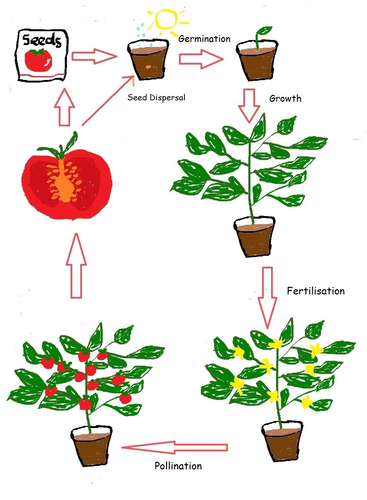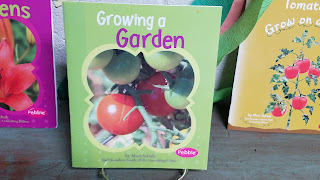All about Seeds and Plants
Plant Lifecycle
We continued our discussion about plants this week by
understanding the basics of the plant life cycle.
I gave an example: You plant a tomato seed in a pot.
It needs fertile soil, warmth, water, and space.
Soon, the seed will germinate and grow.
Now the plant needs sunlight and more water.
The plant will grow leaves. The stem grows UP and the roots grow DOWN.
When the plant develops flowers, pollinators (that we discussed last week)
are needed like bees, butterflies, and bats.
The pollinators move pollen from flower to flower (or from anther to stamen) and the
plant can now reproduce and create fruits and seeds.
The tomato plant creates a tomato which has seeds inside.
You can take seeds from the inside and plant them in soil to create a new tomato plant -
and that is the full plant life cycle!

Each child was able to plant their own (pretend) tomato plant. They had pots, soil, seeds, water, plant labels, and even little sprouts. This is their practice before hopefully going outside to plant their own plants when the weather warms and spring finally arrives!
We continued our education about pollination and pollinators. We made our own bees and we pretended to have our own proboscises (tongues) to drink nectar from the flowers. We also shared the nectar and pollen we gathered at the flowers with our very own hive to make honey!
Here are several of the books we enjoyed this week...
understanding the basics of the plant life cycle.
I gave an example: You plant a tomato seed in a pot.
It needs fertile soil, warmth, water, and space.
Soon, the seed will germinate and grow.
Now the plant needs sunlight and more water.
The plant will grow leaves. The stem grows UP and the roots grow DOWN.
When the plant develops flowers, pollinators (that we discussed last week)
are needed like bees, butterflies, and bats.
The pollinators move pollen from flower to flower (or from anther to stamen) and the
plant can now reproduce and create fruits and seeds.
The tomato plant creates a tomato which has seeds inside.
You can take seeds from the inside and plant them in soil to create a new tomato plant -
and that is the full plant life cycle!

Each child was able to plant their own (pretend) tomato plant. They had pots, soil, seeds, water, plant labels, and even little sprouts. This is their practice before hopefully going outside to plant their own plants when the weather warms and spring finally arrives!
We continued our education about pollination and pollinators. We made our own bees and we pretended to have our own proboscises (tongues) to drink nectar from the flowers. We also shared the nectar and pollen we gathered at the flowers with our very own hive to make honey!
Here are several of the books we enjoyed this week...

















































